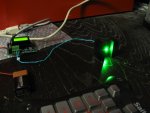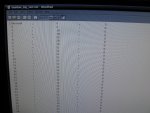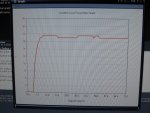I've been using my laserbee for a couple of weeks now. It was the most anticipated and also the most exciting out of all the Christmas presents I bought for myself this year...and I can tell you right now, I bought a lot of laser equipment during the later half of last month and also this month so far. I knew having an LPM (and in particular, the wide band Laserbee) would revolutionize my laser research, and in so doing, up the ante and boost the fun quotient. And it certainly has. I recently restored one of my damaged DPSS lasers, and not only is it working again, it is running at nearly 3x its original specifications. If you think having a laser power meter is something you can put off, or consider to be just a luxury...think again. It's a necessity if you are interested in doing any type of research, or if you hope to have a chance to someday contribute something rather than just copying off of the newest trends in the hobby or merely sitting around being spoon fed information by one of the "gurus".
I had been using my Laserbee I in the usual manner for a few days....seeing how close my guesses were on the lasers I have sitting around the lab, then recording their various stable power levels etc. On its green backlit LCD screen, the Laserbee shows the current power it is reading on the top line in mw, and the peak power on the bottom line. After those first few days of trying out the basic functions of this LPM, Wannaburn suggested that I might be crazy if I hadn't tried out the feature that allows you to perform datalogging to a Windows PC via the serial port (or USB by way of an adapter). Wannaburn was right, being the DPSS jedi he is, and so I decided to put off this review until I tried out that function. I now see that the versatility to perform datalogging is (or should be) the major selling point of this device. It's certainly handy as a quick little 9v laser checker to make sure a unit is up to spec....however, with datalogging, you can use this LPM to do real science.
Here's a picture of the laserbee I, 9v power source, serial adapter, and thermopile (this makes it capable of measuring multiple wavelengths, unlike other LPMs)
I had been using my Laserbee I in the usual manner for a few days....seeing how close my guesses were on the lasers I have sitting around the lab, then recording their various stable power levels etc. On its green backlit LCD screen, the Laserbee shows the current power it is reading on the top line in mw, and the peak power on the bottom line. After those first few days of trying out the basic functions of this LPM, Wannaburn suggested that I might be crazy if I hadn't tried out the feature that allows you to perform datalogging to a Windows PC via the serial port (or USB by way of an adapter). Wannaburn was right, being the DPSS jedi he is, and so I decided to put off this review until I tried out that function. I now see that the versatility to perform datalogging is (or should be) the major selling point of this device. It's certainly handy as a quick little 9v laser checker to make sure a unit is up to spec....however, with datalogging, you can use this LPM to do real science.
Here's a picture of the laserbee I, 9v power source, serial adapter, and thermopile (this makes it capable of measuring multiple wavelengths, unlike other LPMs)







